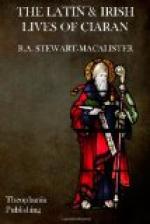(b) This is a thrust at the monastery of Birr. It says, in effect, “Clonmacnois is situated on the great river Shannon, Birr on the insignificant Brosna; and the relative importance of the two establishments is to be estimated by the size of their respective rivers—even Brenainn, the founder of Birr, said this himself!” There was a contest between the people of Clonmacnois and those of Birr at a place now unknown, Moin Coise Bla (the bog at the foot of Bla) in the year 756, according to the Annals of Clonmacnois and of Tigernach. The circumstances which led to this event are not on record; but it is not far-fetched to see an echo of it in the story before us. This would give us an approximate date for the construction of the story, though the compilation in which it is now embedded is considerably later.
(c) This story further exalts Clonmacnois as the place containing a valuable relic that ensures eternal happiness in the hereafter. Of this relic we have already spoken.
(d) Again exalts Clonmacnois by relating a dream in which the founder is put on a level with the great Colum Cille. This vision is related also in the Lives of the latter saint (see, for instance, LL, 852). An analogous vision, not related in the Lives of Ciaran, is that of the three heavenly chairs, seen by Saint Baithin. He saw a chair of gold, a chair of silver, and a chair of crystal before the Lord. As interpreted by Colum Cille, the first was the seat destined for Ciaran, on account of the nobility and firmness of his faith; the silver chair was for Baithin, on account of the firmness and brightness and rigour of his faith; and the third was for Colum Cille himself, on account of the brightness and purity—and brittleness—of his faith.[18]
XXIX. THE PARTING OF CIARAN AND FINDIAN (VG)
Compare with this narrative the parting of Senan and Notal (LL, 2031). The metre of the stanza is cummasc etir rannaigecht mor ocus leth-rannaigecht (seven-syllable and five-syllable lines alternately, with monosyllabic rhymes abab). The translation is literal.
XXX. THE ADVENTURES OF THE ROBBERS OF LOCH ERNE (LB, LC)
LA and VG know nothing of the visit to Loch Erne of which this is the chief incident. Ninned here appears as an abbot, which is scarcely consistent with his previous appearance as a junior fellow-student of Ciaran. There is, however, a possible hint at this tradition in the statement in VG that when Ciaran departed from Clonard he left the Dun Cow with Ninned. Ninned’s island, as we learn from an entry in the Martyrology of Donegal (18th January) was Inis Muighe Samh, now spelt Inismacsaint, in Loch Erne. The reading in both MSS. of LB, silua for insula, evidently rests on a false interpretation of a word or a contraction in the exemplar from which R1 was copied. This seems to have been hard to read at the incident before us. Later on there is a word, which the sense shows us must have been potentes. The scribe of R1 could not read it, and left a blank, which he afterwards tentatively filled in with the meaningless word fatentes—a word which his copyist, the scribe of R2, emended by guesswork into fac(i)entes.




